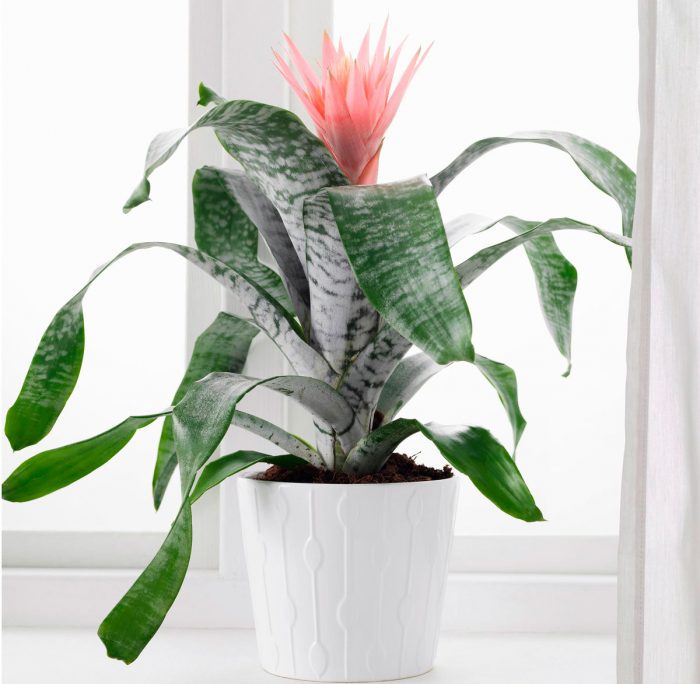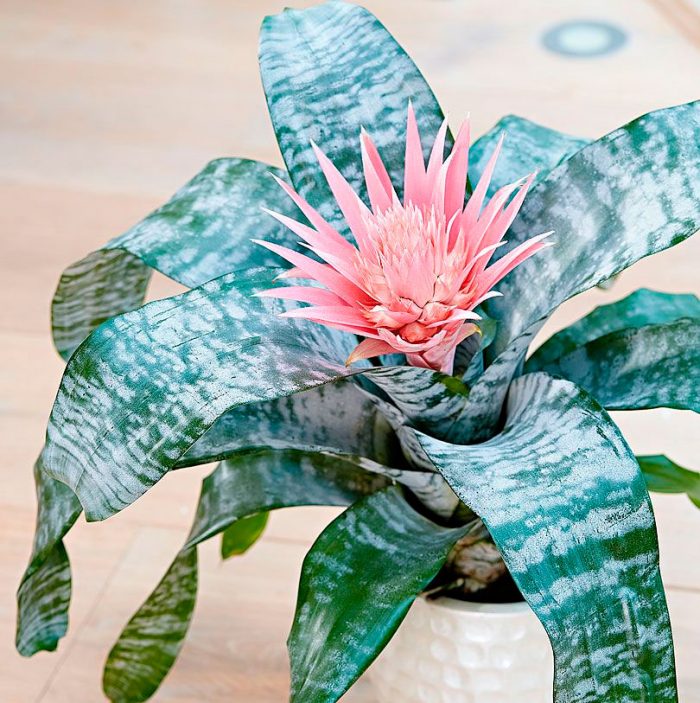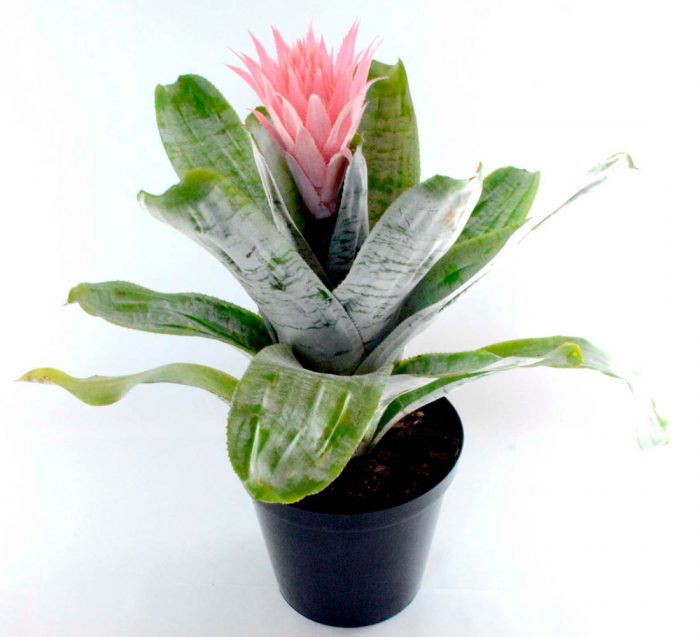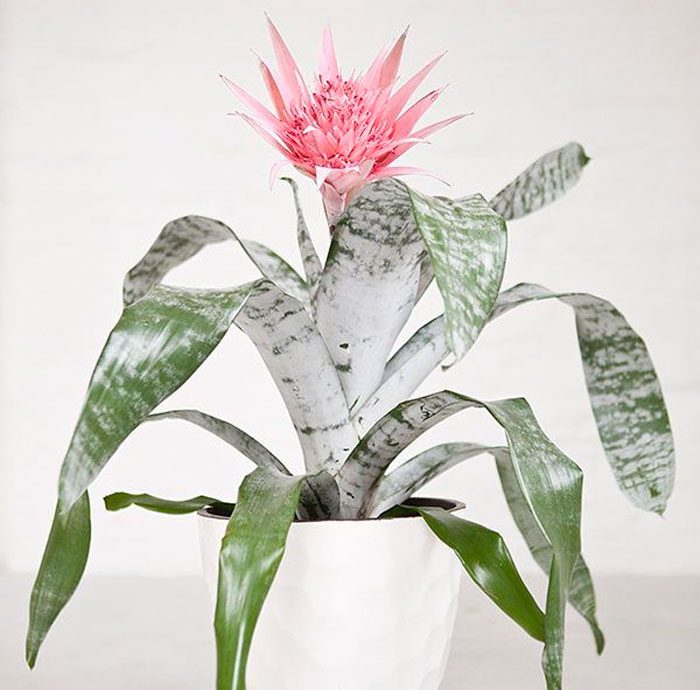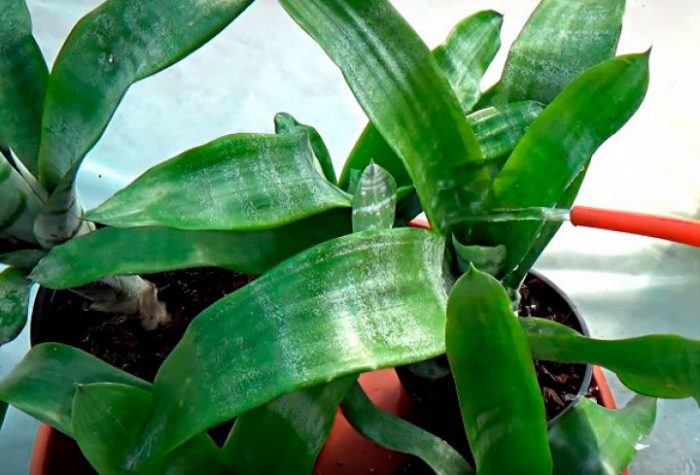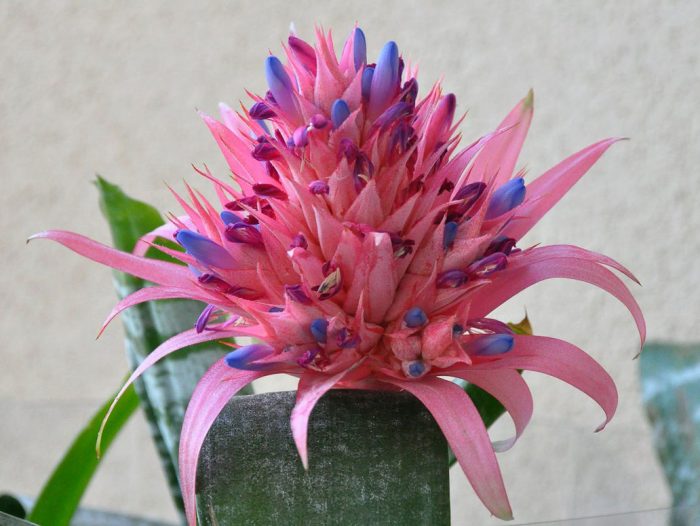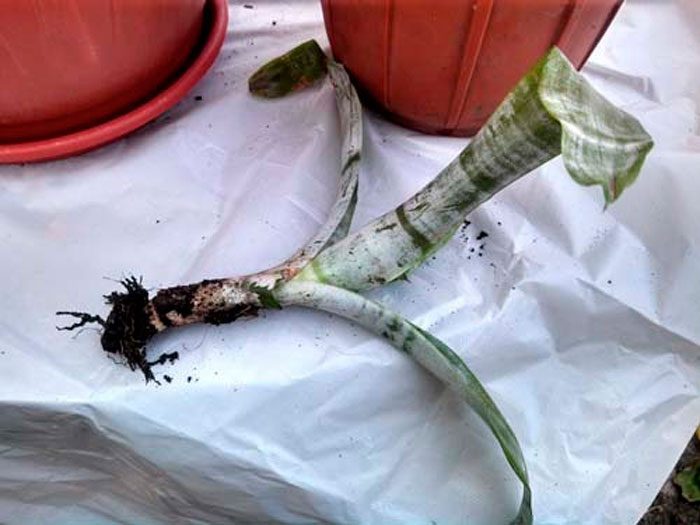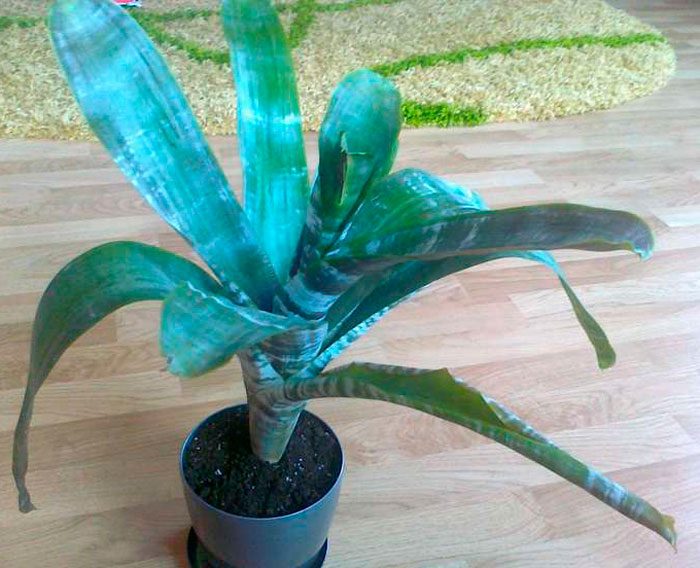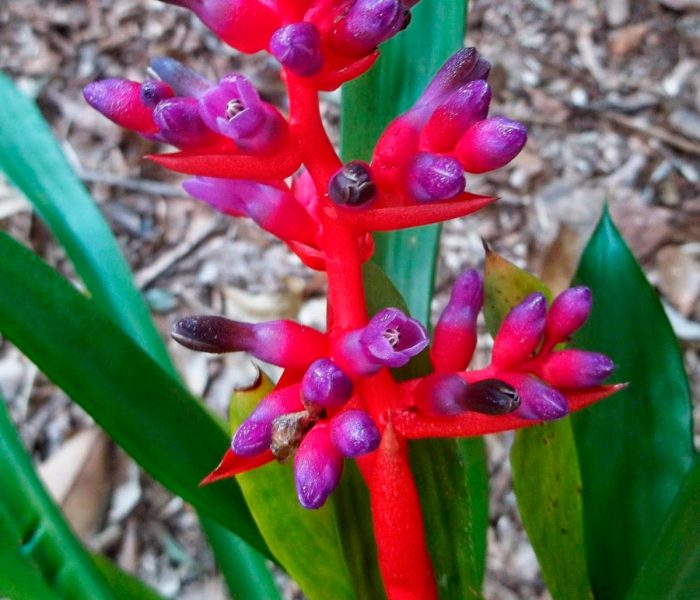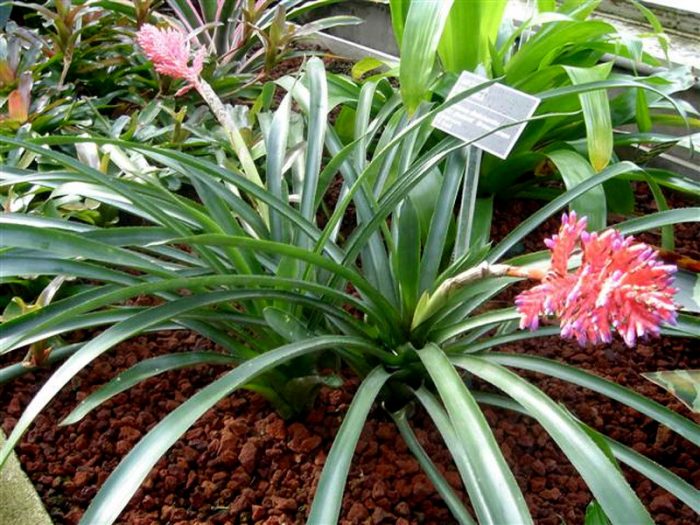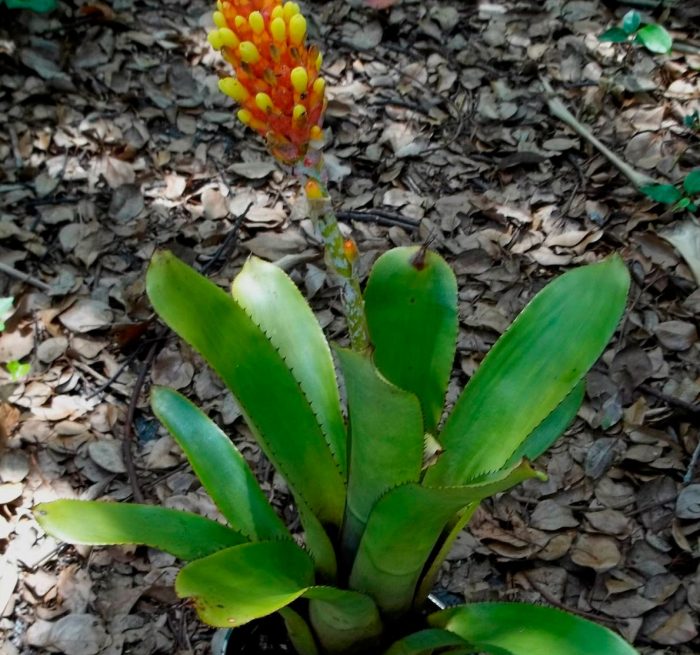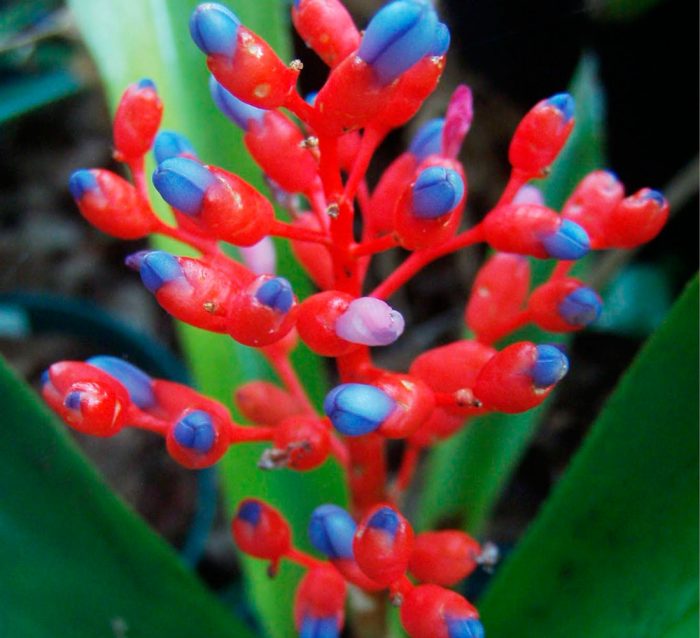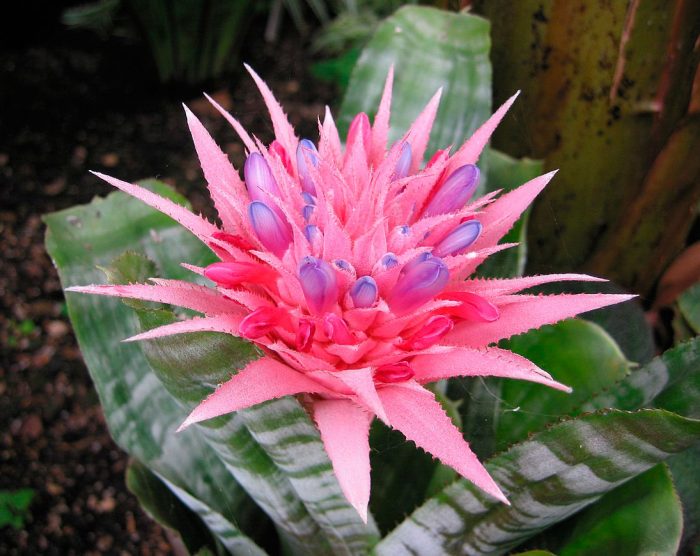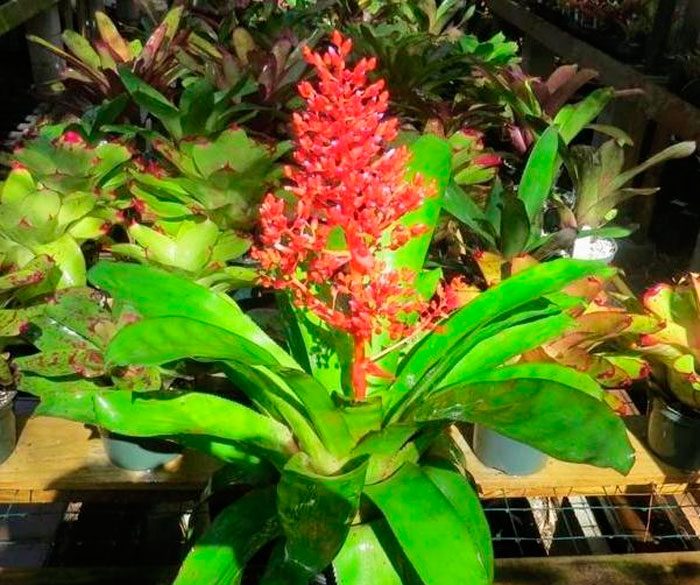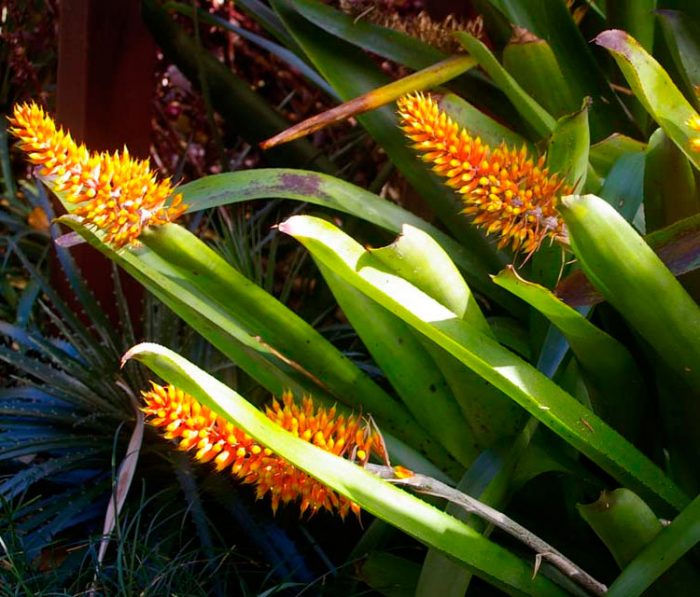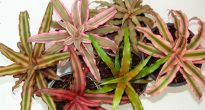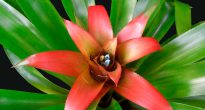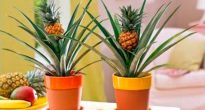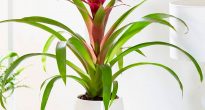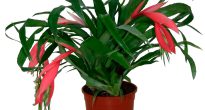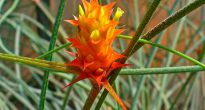The echmea plant (Aechmea) is a member of the bromeliad family. This genus unites approximately 180 species. In nature, they are most often found in Central and South America. The name of the flower comes from the Greek word "aechme", which translates as "tip of the peak", this is due to the unusual shape of the bracts.
Content
Ehmei features
Among the numerous species of the genus Echmeya, both terrestrial and epiphytic plants are found. This plant differs from other representatives of the bromeliad family in that thorns are located on the edge of the foliage. The leaves form a rosette, while their color can be variegated or monochromatic, and they are also soft leathery or dense tough. The fruit is a berry.
Ehmeya is quite popular with flower growers, even though each rosette of leaves can bloom only 1 time. This plant also differs from other bromeliads in that it is quite simple to grow it indoors.
Brief description of cultivation
- Bloom... In summer or last winter weeks.
- Illumination... A bright light is needed, which must be diffused.
- Temperature regime... In the summertime - from 22 to 26 degrees, and in winter - from 15 to 18 degrees.
- Watering... In the warm season, the flower is watered abundantly immediately after the top layer of the soil mixture dries out. If the weather is warm outside, then lukewarm water is used for irrigation (a little warmer than room temperature), while it must be poured into the funnel formed by the foliage. When the bush fades and during the dormant period, during watering, you only need to moisten the soil mixture in the pot after it dries out to a slightly greater depth than in the summer.
- Air humidity... It should be slightly above average. The bush is regularly moistened from a spray bottle, and wet expanded clay should be poured into the pallet.
- Fertilizer... In the spring-summer period, feeding is carried out 1 time in 15-20 days, in the autumn time - 1 time in 30 days, and in winter - 1 time in 1.5 months. To do this, use a solution of complex mineral fertilizer for bromeliads.
- Dormant period... It is not pronounced.
- Transfer... The procedure is carried out every year in the spring, when the bush has faded, while all faded sockets are cut off from it.
- Soil mixture... It should include sand, deciduous soil and peat (1: 2: 1).
- Reproduction... By offspring and seed method.
- Harmful insects... Aphids, scale insects and root worms.
- Diseases... Decay of the leaf rosette, lack of flowering, as well as the formation of brown specks on the surface of the leaf plate. All these problems are associated with irregular care or improper conditions of detention.
- Properties... Ehmeya striped can cause skin irritation.
Home care for echmea
Illumination
When growing ehmea at home, it is recommended to choose a window sill of western or eastern orientation for it. The fact is that the scorching midday direct rays of the sun can harm her. If there is a place for a flower only on the southern window, then it must be protected from direct sunlight at lunchtime. If the weather is warm in summer, then it can be transferred to fresh air (in the garden or on the balcony). However, it is necessary to accustom the bush to new conditions gradually, otherwise burns may form on the surface of its foliage. Also, you need to gradually accustom to bright light the copies recently purchased in the store, and even if the weather was cloudy for a long time.
When growing sparkling echmea, it should be borne in mind that it tolerates direct sunlight worse than all other species. In this regard, it is recommended to grow it in a shaded place. And the curved ehmeya needs a very large amount of bright light from the sun, otherwise the foliage loses its color, and its flowers become less attractive.
Temperature regime
In the warm season, the flower needs warmth (from 22 to 26 degrees), and in winter it is recommended to rearrange it to a cooler place (from 15 to 18 degrees). To stimulate flowering and normal peduncle formation, differences between the air temperature at night and during the day are recommended.
Ehmeya grows well in the fresh air, which is why the room where it is located should be systematically ventilated. However, make sure that it is reliably protected from drafts. Ehmeya sparkling does not need frequent ventilation, while it hibernates at a higher air temperature.
Watering
During the watering of the flower, water is poured both directly under the bush and into the middle of the leaf outlet. At the same time, the water should be soft, well-settled and slightly warmer than room temperature.
In spring and summer, watering should be abundant, while water is poured into the center of the leaf outlet. The procedure is carried out immediately after the top layer of the soil mixture in the pot dries up. With the onset of autumn, watering becomes more rare and scarce, and water begins to be poured gently under the bush, and not into the outlet. During cold wintering, ehmeya is watered carefully, and if there is such a need, then slightly moisten the surface of the foliage from a spray bottle with lukewarm water. Remember that after the bush has faded and during the rest period, pouring water into the outlet is prohibited, because this causes rot on the flower, and this can lead to its death.
Air humidity
Such a plant will not suffer much due to the low air humidity, which is often observed during the heating season. However, in order for it to grow and develop well, it is recommended to slightly increase the humidity level. To do this, it is recommended to systematically moisten the ehmeya from a sprayer with warm, soft, well-settled water, and the flower pot can also be put on a pallet filled with moistened expanded clay or pebbles.
Fertilizer
In order for echmea to develop within normal limits, it should be fed throughout the year. Mineral complex fertilizer in liquid form is suitable for this.In the spring-summer period, fertilizers are applied to the soil at intervals of 1 time in 2-3 weeks, in the fall - 1 time in 4 weeks, and in winter - once every 6 weeks.
Bloom
In order to stimulate echmea flowering, a method that has been known for a very long time is recommended. The flower together with the pot is placed in a polyethylene bag and 2 or 3 ripe apples are placed there. Tie the bag loosely and leave the flower for 1.5-2 weeks. Flowering will begin after 4 months.
Ehmeya transplant
Ehmeya is grown in the most common flower pot. At its bottom, a not very thick layer of drainage from expanded clay or pieces of brick is necessarily made. A suitable substrate should consist of peat, sand and deciduous soil (1: 1: 2). To grow a flower, you can also use a soil mixture consisting of humus and deciduous soil, as well as sphagnum (1: 1: 1); it is imperative to add a small amount of fine shards and sand to it. It is transplanted every year in the spring, when the flowering ends, at the same time, those leaf rosettes that have faded are removed. Also, ready-made commercial substrate for bromeliads is suitable for growing echmea.


Watch this video on YouTube
Virulence
Echmea striped contains poison that can irritate the skin. In this regard, it is recommended to work with such a flower only with protective rubber gloves. And when the work is over, do not forget to wash your hands thoroughly with soap and water.
Reproduction methods
How to propagate by offspring
For reproduction of room echmea, the vegetative method is most often used. For this, in the first spring weeks, the offspring are separated from the adult bush, which should be more or less developed. They will root quickly enough after planting in a separate pot. Places of cuts on the parent bush and on the offspring are treated with coal powder, otherwise rot may appear on the flower. For planting offspring, small individual pots are used, which are filled with one of the soil mixtures listed above.
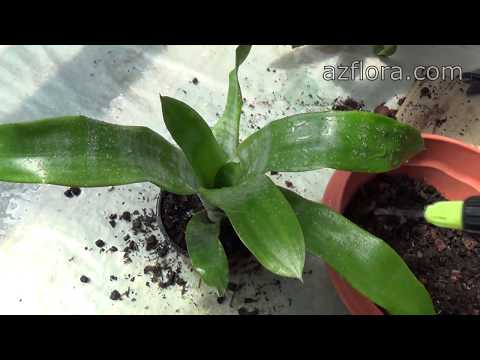

Watch this video on YouTube
Growing from seeds
If desired, such a flower can be grown from seeds. However, this method has several drawbacks, namely, it is more complicated and time-consuming, and seedlings grown from seeds may not retain varietal characteristics.
For sowing seeds, the selected container is filled with chopped fern roots, peat or finely chopped sphagnum. Crop maintenance is pretty simple. They need to be placed in a warm (22 to 24 degrees) and shaded place, in addition to this, they are provided with systematic watering and airing. 3 months after sowing, the seedlings should be cut into a substrate consisting of leafy and heather soil. And when another 12 months have passed, the grown seedlings can be transplanted into the substrate that is used for planting adult specimens (see above). During a given year, the plants need to be watered moderately, the foliage should be moistened with a sprayer, and they should also be kept warm (20 to 26 degrees).
Possible problems
- The leaves turn brown... Most often, the echmea foliage turns brown if the bush is grown in a too cold place. It can also happen when rot appears on the bush.
- Ehmeya does not bloom... The bush does not bloom if the lighting is extremely poor, especially for variegated forms. The lack of light also causes the foliage to lose its characteristic color.
- Harmful insects... Scales, aphids, and root worms can sometimes settle on such a plant. To get rid of them, the plant is treated with a solution of a special insecticidal preparation.
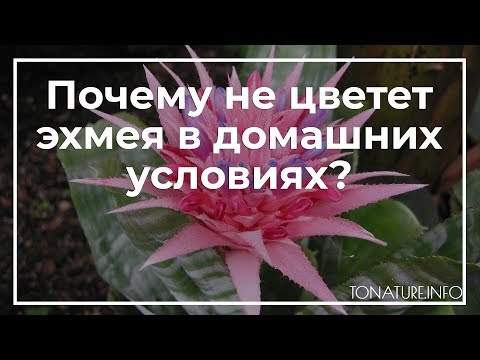

Watch this video on YouTube
Types of ehmea with photos and names
Ehmea Weilbach (Aechmea weilbachii)
Or Weilbach's lamprococcus (Lamprococcus weilbachii).Linear-xiphoid soft leathery leaf plates are collected in a rosette, their length is about half a meter, at the top they are sharpened, while the edge is covered with small thorns. They are painted greenish-red. The straight upward peduncle is about 50 centimeters long and is covered with many small crimson leaves. The complex inflorescence has the shape of a brush. The color of the bracts is deep red. The petals of the flowers are lilac-blue, and their edge is white, there are also sepals that have grown together by 1/3.
Ehmea two-row (Aechmea distichantha)
Or Platyaechmea distichantha. This species is represented by both epiphytes and terrestrial plants. A loose, spreading rosette of leaves reaches about 100 cm in diameter. Long narrow leaf plates in the upper part are pointed, they are colored green, their width is about 3 centimeters, and their length is up to 50 centimeters. On the edge are dark brown thorns growing very close to each other. The height of the peduncle is more than 0.6 m. The color of the flowers is lilac, and the bracts are deep red. There is a variety - variegata: leaf plates are decorated with white stripes, which are located on the edge.
Ehmea curved (Aechmea recurvata)
Among the representatives of this species, there are both terrestrial plants and epiphytes. Linear leaf plates are assembled into an outlet, on one bush there are from 6 to 12 pieces. Their length is slightly less than 50 centimeters, while their width is about 15 mm, from top to bottom they grow together into a tube, the edge is covered with spikes 2 mm long. The capitate inflorescence reaches a height of only about 20 centimeters. The length of the petals of red flowers is about 25 mm, the bracts are also red. Such a plant blooms in spring.
This species has a variety of ortgiesii. The leaf rosette reaches a height of only 15 centimeters. Leathery leaf plates are directed upward at an angle. Their width is about one and a half centimeters, and their length is up to 30 centimeters, the edge is covered with small thorns. The color of the bracts is red, and the flowers are pink.
Ehmea shaggy (Aechmea comata)
Or Ehmea Linden (Aechmea lindenii). Belt-like sheet plates are about 5 centimeters wide and up to 100 centimeters long, they are assembled into a socket. Their upper part is spinous, but rounded, the edge is covered with small teeth. The shape of the inflorescence is spiky. The bracts in this species are red, and the flowers are rich yellow. Blooms in the winter.
Echmea matte red (Aechmea miniata)
A funnel-shaped rosette consists of a large number of leaf plates, the width of which is up to 2 centimeters, and the length is about half a meter. They are colored green, taper towards the base and have a lilac tint in this part, the upper part is shortly pointed. The edge of the foliage is covered with small teeth, and there are a few scales on its surface. The red straight peduncle is directed upwards. The apical inflorescence is pyramidal. The sepals are red and the flowers are bluish. Small fruits are colored deep pink. The flowering of such a plant is long.
Echmea striped (Aechmea fasciata)
Or striped bilbergia (Billbergia fasciata). The shape of the leaf rosette is tubular, in diameter it reaches about 100 cm.The length of the greenish-gray belt-like foliage is up to 0.6 meters, and its width is about 6 centimeters, on the surface there are transverse stripes of a marble-white hue. There are scales on the surface of a straight upward peduncle. The length of the complex pyramidal-capitate inflorescence is about 0.3 m, there are pink adherent leaves. The blue color of the flowers changes over time to reddish blue. There is pubescence on the surface of the sepals.
Ehmea sparkling (Aechmea fulgens)
The shape of the foliage collected in the outlet is belt-like, and its color is green. The leaves are about 6 centimeters wide and slightly less than half a meter long. Their top is rounded, and the edges are covered with denticles. The color of the flowers is coral red, and the bracts are pink. During flowering, up to 100 flowers are formed on the inflorescence.
The discolor variety is cultivated by flower growers: the color of the seamy surface of the foliage is reddish-purple, and the front one is olive green.
Echmea caudata (Aechmea caudata)
The deep green leaf plates, collected in a rosette, are angled upward, they are decorated with a strip of creamy yellow that runs along the edge. On a long peduncle, a panicle-shaped inflorescence is formed, consisting of golden flowers.


Watch this video on YouTube

